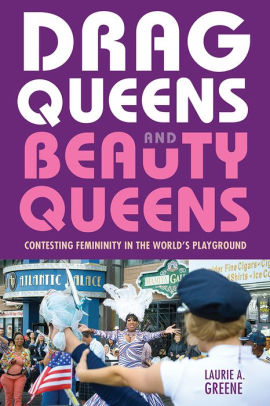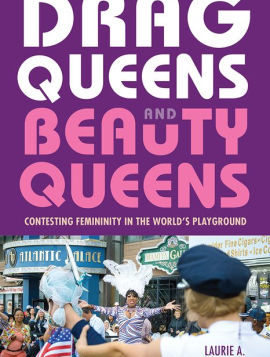 DRAG QUEENS AND BEAUTY QUEENS
DRAG QUEENS AND BEAUTY QUEENS
Contesting Feminity in the World’s Playground
by Laurie A. Greene
Rutgers University Press, 232 pages, $24.95
“RECOUNTING THE HISTORY of marginalized communities is always important, even more so when the population in question is absent from so many of its storytellers,” writes Stockton University anthropology professor Laurie A. Greene to describe the once vibrant gay scene in New Jersey’s Atlantic City, which was decimated by AIDS and gentrification. Drag Queens and Beauty Queens is an ethnographic study that analyzes the symbiotic relationship between a “pair of spectacles”: the 100-year-old Miss America pageant (which Greene calls a “performance of gender” that’s “understood by gays as essentially a camp performance”) and its “drag counterpart,” the Miss’d America pageant.
Created in the 1990s by drag queen Sandy Beach, Miss’d America was originally held on the day after the official event—the joke being that its contestants had arrived in Atlantic City a day late. According to Greene, the Miss America pageant is part of “the regulation of femininity from within the culture and policy of a nation.” As such, it provided drag queens, who were already involved in deconstructing these notions, with source material to riff on. As “queens” of a sort, they were naturally interested in being crowned.
Aiming to offer “academically accurate and informative analysis in plain, jargon-free language,” Greene interviewed over thirty drag queens connected to the scene. Topics she touches upon include the origins of pageantry, the definition of camp, and the influence of RuPaul’s Drag Race upon drag (advocates praise an increased visibility for the art form; detractors bemoan the commodification of drag). She also explores identity politics as expressed in drag performance (“camp was valued over polish, message over presentation”) and discusses the impact of AIDS, technology, and racism upon drag performance.
Greene begins with the history of the host city. Close to New York City, Philadelphia, and Washington, Atlantic City billed itself as the “premier world vacation resort,” eager to cater to the needs and desires of its ever-changing tourist population (serving booze during Prohibition, opening its first casinos in 1978). The Miss America pageant that emerged in 1921 had its origins in a swimsuit competition staged to promote the beaches (though the Swimsuit category was eliminated from the competition in 2018). Other changes made in the upgrade to “Miss America 2.0” included jettisoning the theme song (made popular by its longtime host Bert Parks) and the runway segment. “Fighting continued accusations of misogyny and irrelevance,” the once-kitschy pageant is now promoted as a “scholarship contest.”
Greene posits that the gay community living adjacent to the Boardwalk—especially in the 1970s, along its former hub, New York Avenue, now “mostly empty, overgrown lots strewn with debris”—established its identity in relation to the Miss America pageant, which in turn it strongly influenced. For example, the popular Show Us Your Shoes parade, in which contestants ride in the back of convertibles modeling artfully designed footwear meant to evoke and celebrate their home states, arose after a few eagle-eyed gay men in a balcony overlooking the parade route noticed that “the girls were wearing bedroom slippers and socks with these gorgeous gowns on.” According to drag queen Sandy Beach, it was their heckling that prompted some participants to focus on footwear in the new parade.
While the subject matter is fascinating, Greene’s treatment of it feels lopsided. We’re told too much about what the Miss America pageant has become (stodgy, self-important, serious) and not enough about what made it so appealing in its heyday. The decision to organize the book by theme rather than chronologically results in a lot of repetition. The prose is accessible to general readers but still rather dry and academic. Greene seems to place her interviewees on a pedestal and tiptoes around them as they talk, afraid of interrupting, leaving the reader to cry out: “Get to the point!” Perhaps this cautious tone is due to Greene’s awareness that both pageants are “at a crossroads” as they confront questions of relevance going forward.
____________________________________________________






